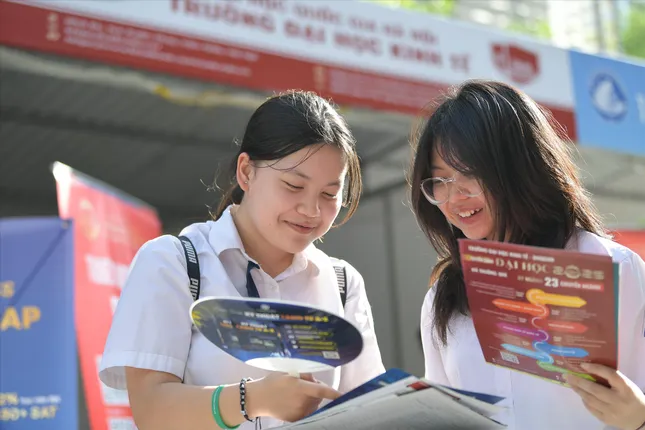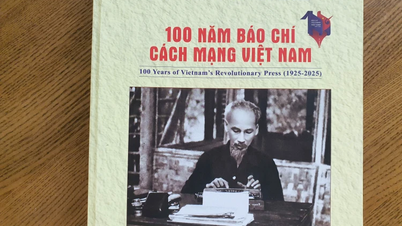Average score deviation over 100 points
Ho Chi Minh City National University (HCMC National University) has just announced the score distribution of the two-round competency assessment exam with over 223,000 candidates taking the exam. According to statistics from the Center for Testing and Training Quality Assessment (HCMC National University), this year, over 8% of candidates scored 901/1,200 points or higher (4.4% higher than last year); scores of 701 or higher accounted for 40% (37% in 2024). Based on the actual number of candidates, this year the number of candidates with high scores increased sharply compared to last year in each score range. However, this year the number of candidates taking the exam was about 30% higher than last year.
There was also a significant difference in scores between the first and second rounds of the competency assessment exam organized by Ho Chi Minh City National University. The average score of more than 92,000 candidates in the second round was 718.7, 100.4 points higher than the first round. This difference is currently the highest since the organization of this exam. The second round is becoming an opportunity for candidates to "seize their fate" if they really focus on studying.
An expert in testing analyzed the score distribution and basic statistics from the two rounds of the exam, showing significant differences in results, raising important questions about standardization and fairness between the rounds. According to this expert, based on descriptive statistics, the average score (718.7) and median (728) of round 2 were significantly higher than those of round 1 (average score 618.0; median 609). In addition, the lowest score of round 2 was also nearly twice as high as that of round 1 (81 compared to 40).
 |
Candidates learn about admission information for 2025. Photo: Duong Trieu |
However, the expert said there was a significant difference in the results between the two rounds. The average, median and floor scores of the second round were significantly higher than those of the first round. The score distribution of the second round shifted to the right, so it cannot be completely explained by the factor of candidates retaking the exam or being better prepared.
“This shows that the test may not have been fully standardized or the difficulty level between the rounds has not been balanced, causing risks to fairness if the results of the two rounds are used together. It is also necessary to consider the possibility that there will be a group of candidates who will retake the test in the second round with higher experience and preparation. However, this does not completely explain the large shift in the entire score distribution, especially the increase in the floor score,” the expert said. Therefore, if the scores of the two rounds are used together in the admission process, it may affect fairness for candidates, especially those who only take the test once.
According to experts, the average score of the competency assessment exam of the two national universities (a large number of schools use it for admission) tends to increase compared to last year. In addition,universities use too many admission combinations, so this year's benchmark score is very difficult to predict.
To minimize the above unfairness, solutions should be implemented such as applying the method of standardizing scores between sessions (such as standardizing by percentile rank) to ensure fair comparison. Building a standardized question bank, ensuring equivalent difficulty, and testing the quality of questions. Publicly and transparently disclosing the technical parameters of the exam (standardized score spectrum, discrimination index, difficulty level) to increase social trust.
It is known that the results of the competency assessment exam organized by Ho Chi Minh City National University have the largest scale and number of university educational institutions using it for enrollment at present.
Remove the recruitment combination contract
Before 2024, the Ministry of Education and Training controlled the number of combinations when considering admission for each major. The 2025 university admission regulations have removed this regulation. Therefore, many schools have an "infinite" number of combinations for admission. The University of Foreign Languages (Vietnam National University, Hanoi) has just announced an admission plan with 5 admission methods. In which, the method of considering high school graduation exam results, the school determines the combination according to the formula: Literature (or Math, one of the two compulsory subjects in the admission combination, according to the admission regulations), foreign language (1 of 7 foreign languages held in the high school graduation exam) and any 1 subject in the 9 subjects chosen by students and 42 combinations are formed for admission.
Vietnam-Japan University (Vietnam National University, Hanoi) has just announced information on regular university enrollment in 2025. Accordingly, the school uses 33 combinations for admission. Of which, the major with the most admissions has 13 combinations. Notably, Vietnam-Japan University enrolls 750 students for 9 majors and training programs. The Smart and Sustainable Agriculture major takes 20 students but still considers 13 combinations.
The University of Science and Technology (Vietnam National University, Hanoi) uses 28 admission combinations, many of which include subjects such as Literature, History, Geography, and English. In 2025, out of 17 training majors of the University of Science and Technology of Hanoi (Vietnam-France University), there are 6 majors that will admit students with 4-6 combinations. The Space Science and Satellite Technology major will admit students with the most combinations (20 combinations). Many other majors at the university also have a large number of admission combinations, such as Applied Mathematics with 19 admission combinations; Food Science and Technology, Medical Science and Technology enroll students with 13 combinations. The majors of Pharmacy, Information Security, Information Technology - Communications, and Data Science each have 12 admission combinations.
It can be seen that the quota for each major of the schools is only about a few dozen to 100 - 200, but spreading out the combination of candidates for admission shows that on the one hand, it creates conditions for all candidates, but on the other hand, it shows that the schools are trying to "sweep candidates", which potentially risks destabilizing the system and causing chaos in admissions.
Source: https://tienphong.vn/nguy-co-mat-cong-bang-trong-tuyen-sinh-dai-hoc-post1751435.tpo











































































































Comment (0)